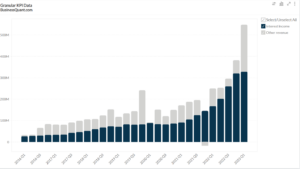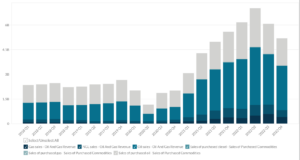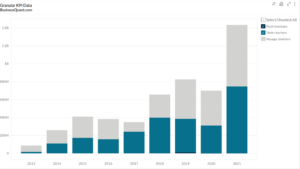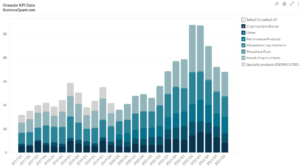
Aurora Cannabis: Cost Per Gram (Medical, Quarterly)
Exclusive Data
You need the Pro Plan to access KPI data
- Full access to the platform
- KPI data & segment financials on US stocks
- Financial data on thousands of stocks
- Download data in xlsx and csv formats
Pro Plan
$49 per month*
60% discount ends in:
.
About
More information
Subscribe to Pro or Enterprise plans to unlock this feature.
Contact the Analyst
Subscribe to Pro or Enterprise plans to unlock this feature.
Become a smarter investor today.
Access KPIs & Segment Financials on US stocks
This statistic highlights Aurora Cannabis’ Cost Per Gram of Medical cannabis from Q3 2017 onwards. This includes cash cost of production and sales per gram.
Aurora Cannabis: Cash Cost to Produce and Cash Cost
Both of these metrics are non-IFRS, which uses non-standardized methods and may differ from company to company. Aurora Cannabis’ cash cost of sales is generally calculated by the total cost of sales as per IFRS and deducting the fair values of biological assets, non-cash production cost, any purchase from other licensed producers and cost of sales from service revenue, which is to be divided by the number of grams produced in the period. Whereas cash cost to produce is post-production cost, which can be derived easily by deducting packaging cost from the cash cost of sales. The reported figures may vary from company to company.
This is extremely important metric in the cannabis industry as it helps investors to understand which producer, among all, has a cost advantage. This, in turn, allows us to assess the competitiveness and profitability of licensed cannabis producers.
- Year 2017:
The year has recorded the highest revenue in Q4 of $5.9 million, up by 15% from Q3 2017, including the sale of 7,55,059 grams of cannabis. The company saw continued patient growth as well as revenue growth since the launch of commercial operations in January 2016. Acquisition of Peloton pharmaceuticals and additional investment in constructing new production facility in Alberta and Quebec cities helped the company to increase the production capacity, which in turn increased the revenue and made the company to reduce the cash cost of sales and maintain the same cash cost to produce for Q3 and Q4.
- Year 2018:
Aurora strengthened its financial and liquidity position during the third quarter with $3,56,266 by issuing debentures and warrants. The company continued to grow its aggressive business and operating strategies that include major domestic and international expansion projects. With the acquisition of CanniMed facilities and lower utility costs in summer months, the cash cost of sales and cash cost to produce increased by $0.7 and $1.7 in Q4, respectively. The company also invested heavily in Sky Class facility around $120 million, with a view that it will reduce the cost of producing a gram of cannabis to $1 per gram.
- Year 2019:
Due to the increased production volume and higher plant yield, the company spotted a drop-in cash cost to produce to $1.14 per gram in Q4, down by 19.7% from the previous quarter. Because of the new regulatory requirements under the cannabis act, the company faced an increase in packaging costs, which leads to the higher differences between cash cost to produce and cash cost of sales during the year.
- Year 2020:
Cash cost to produce decreased to $0.85 per gram, down by 25% from the previous quarter, merely because of the hike in the production volume by 43%. But the case is opposite in Q2; it saw a decrease in production volume by 26% to 30,691 kilograms resulting in low absorption of overheads. Cash cost to produced also increased to $0.88 gram, up by 4% from $0.03 in Q1 2020.
Did you like Aurora Cannabis’ Cost Per Gram of Medical cannabis statistic?
Access more such KPI data points and segment financials on thousands of US stocks, with Business Quant.
You can get started here.
More data on US Stocks

Our Plans
Always know what you’ll pay. No hidden costs or surprises.
- Annual
- Monthly
60% discount until this Sunday
Pro
For serious investing
-
Company KPI data Access segment financials, non-GAAP metrics and KPI data from presentations and filings. Examples include financials by segment / region / product category, AT&T's broadband subscriber trends, Tesla's deliveries by model and lots more.
-
Stock research tools Features include : stock screener, stock comparison, industry financials, stock warnings, advanced charting tools, timeseries tables, scatter charts, financial statements, stock reports, SEC filings, stock ratings, institutional and insider ownership data. There are 200+ financial items and ratios on thousands of US stocks.
-
Industry data & tools Access premium operating data on 40+ industries. Examples include market share, smartphone shipments by vendor, subscribers by wireless carrier, historical gold production. There are 20,000+ such statistics.
Enterprise
For tailored workflows
-
All of Pro plan Get unfettered access to all our dashboards and dossiers.
-
Custom built features Get tailored dashboards built specially for you , based on your set of requirements, to simplify your research workflow.
-
Admin billing Back-end documentation support and multi-seat licensing.
* Billed annually, local taxes extra.
60% discount on Annual plan
Pro
For serious investing
-
Company KPI data Access segment financials, non-GAAP metrics and KPI data from presentations and filings. Examples include financials by segment / region / product category, AT&T's broadband subscriber trends, Tesla's deliveries by model and lots more.
-
Stock research tools Features include : stock screener, stock comparison, industry financials, stock warnings, advanced charting tools, timeseries tables, scatter charts, financial statements, stock reports, SEC filings, stock ratings, institutional and insider ownership data. There are 200+ financial items and ratios on thousands of US stocks.
-
Industry data & tools Access premium operating data on 40+ industries. Examples include market share, smartphone shipments by vendor, subscribers by wireless carrier, historical gold production. There are 20,000+ such statistics.
Enterprise
For tailored workflows
-
All of Pro plan Get unfettered access to all our features.
-
Custom built features Get tailored dashboards built specially for you , based on your set of requirements, to simplify your research workflow.
-
Admin billing Back-end documentation support and multi-seat licensing.
* Local taxes extra.






